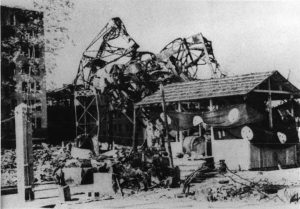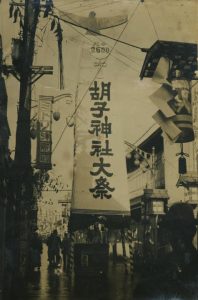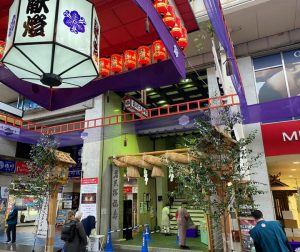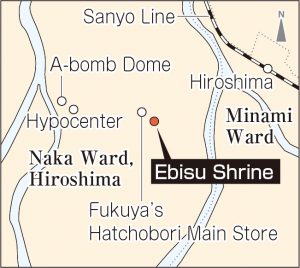Striving to fill voids in Hiroshima, evidence of victims remains—Records of A-bombing disaster, Part 5: Ebisu Shrine
Jan. 7, 2022
Temporary shrine structure built on scorched earth to preserve tradition
by Kyosuke Mizukawa, Staff Writer
In the area of Ebisu-cho in Hiroshima City (now part of the city’s Naka Ward), about 850 meters from the hypocenter, a simple structure decorated with traditional curtains and a large Japanese drum inside stands next to a bent and twisted steel frame. That simple structure served as a temporary Ebisu Shrine building rebuilt in the fall of 1945 on the ruins of the atomic bombing. The skeletal frame used to be a building of the kimono wholesaler Odamasa Shoten that served as both a retail shop and a warehouse.
The photograph was taken by Kazuma Hayashi, a former employee of the Fukuya Department Store, which still stands near the shrine today, who died in 1979 at the age of 84. Mr. Hayashi remarked in the Record of the Hiroshima A-bomb Disaster that the temporary shrine, appearing shortly after the atomic bombing, “left a vivid impression because it was the only building standing amid ruins that stretched as far as the eye could see.”
Temporary shrine gave local residents hope for reconstruction
The Ebisu Shrine, which is dedicated to the deity of business prosperity and had earned the faith placed in it by the people of the area, was said to have been founded in 1603. Miyako Makino, 87, a current resident of Hatsukaichi City who was raised near the shrine, remembers the elaborate Ebisu Grand Festival held before the war every November. “The street was lined with stalls selling bamboo rake charms symbolizing the raking in of good fortune and packed with so many people coming and going that I could only see their heads.” The shrine was also a place where local people interacted, with children’s gatherings held each Saturday.
Story has it that there were about 80 shops, mostly clothing businesses, in the area of Ebisu-cho in 1940, but everything, including the shrine, was destroyed in the atomic bombing. The surviving townspeople, however, managed to clear the ruins, build the temporary structure, and hold the Ebisu Grand Festival again in November 1945, just three months after the bombing. Although it was of a temporary nature, the shrine gave moral support to local people who were struggling to rebuild their lives.
Ms. Makino lost her parents in the atomic bombing and lived with her grandmother and other relatives in housing near the shrine for about one year. “There was a kind of variety show performed at the shrine in which people sang and danced. I went to see it,” she recalled.
Festival held even during coronavirus pandemic
The shrine building was newly constructed in 1949 and later rebuilt of reinforced concrete. The festival was held the past two years despite the COVID-19 pandemic based on the adoption of strict measures to protect against spread of the virus. The Ebisu Grand Festival in 2022 will mark its 420th occasion. The temporary shrine in the photo conveys to the present day the story of the efforts for reconstruction made by citizens who worked to preserve tradition amid the ravages of the atomic bombing.
(Originally published on January 7, 2022)











